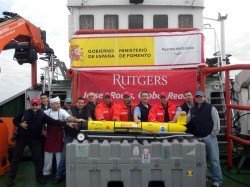Glider Completes Historic Ocean Crossing: New Technology Advances Climate Understanding

The first-ever 7,300-mile Atlantic Ocean crossing by an unmanned underwater glider is opening up a new world of ocean technology.
(From NOAA) — A ceremony on Dec. 9 in Baiona, Spain, will celebrate the partnership effort among the U.S. interagency Integrated Ocean Observing System (IOOS) through Rutgers University, NOAA, Puertos Del Estado (Spanish Port Authority), the National Oceanographic Partnership Program, and other European partners.
“The success of this mission marks an important milestone in ocean observing and opens new frontiers in oceanography,” said Richard Spinrad, NOAA assistant administrator for oceanic and atmospheric research. “It is through efforts like this that we will continue to learn more about the wonders of the ocean at a critical time for our planet.”
The glider, launched off the coast of New Jersey last April, repeatedly dove to depths of up to 200 meters to collect data including temperature, salinity and density. Scientists correlate these data with those from satellite imagery and altimetry, radar systems and seafloor and buoy-mounted sensors to get a more detailed view of a particular patch of ocean in near real time. The glider’s constant motion offers a more comprehensive view of ocean conditions in time and space than the static measurements usually taken from the deck of a ship.

“This data will help us understand what is happening in the ocean, including where and how quickly changes are occurring,” said Zdenka Willis, director of NOAA’s IOOS program. “Collecting this vital data at sea is usually difficult and expensive, but gliders and their evolving and expanding capabilities are now allowing us to explore the ocean in a safer and more economic way.”
The glider was built with custom upgrades that allowed it to dive deeper, track battery life and minimize fouling of instruments due to marine growth. Oceanography undergraduates at Rutgers University were significantly involved in this mission as part of their education program.
Nicknamed the Scarlet Knight, the 7 foot-long, 135-pound glider traversed the ocean over 221 days. A similar attempt was made last year, but that glider was lost around the Azores.

Other partners in the project include Teledyne Webb Research, Universidad de Las Palmas de Gran Canaria, Platforma Oceanica de Canarias, and the Universidade dos Acores, Departamento de Oceanografia e Pescas.
Baiona is where Christopher Columbus first announced to Europe the existence of the New World in 1493.
IOOS delivers the data and information decision makers need to take action to improve safety, enhance the economy and protect the environment. These data provide a larger picture of the interactions between the ocean and atmosphere and advance our understanding of potential climate change impacts on marine ecosystems and coastal communities.
NOAA understands and predicts changes in the Earth’s environment, from the depths of the ocean to the surface of the sun, and conserves and manages our coastal and marine resources.


